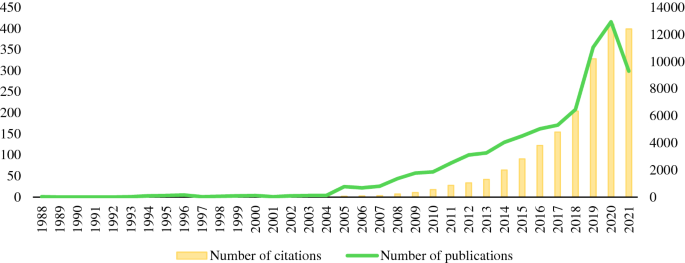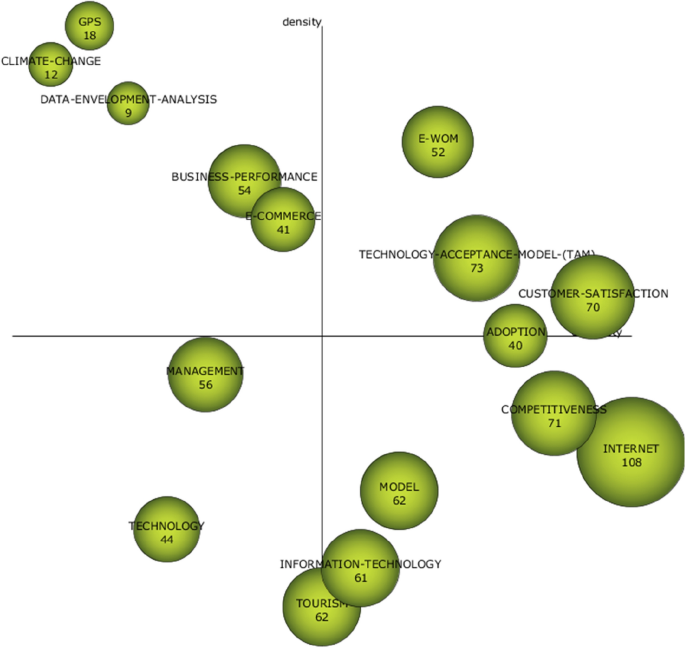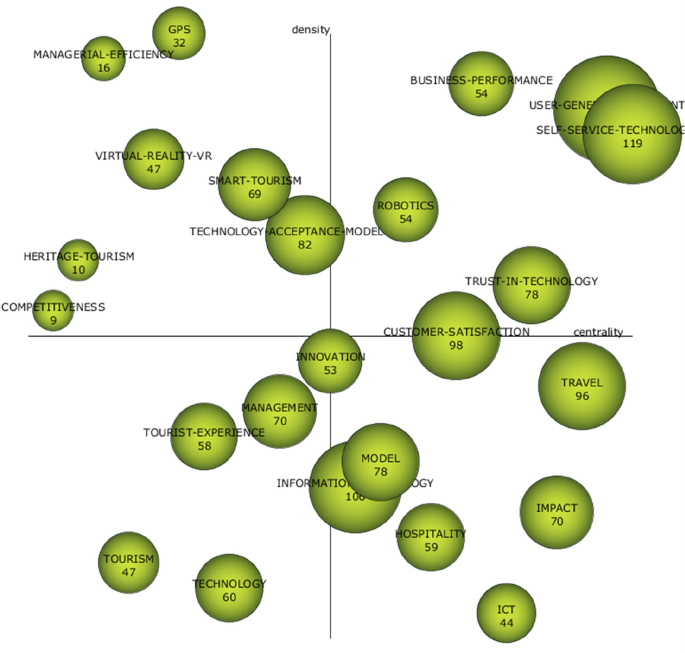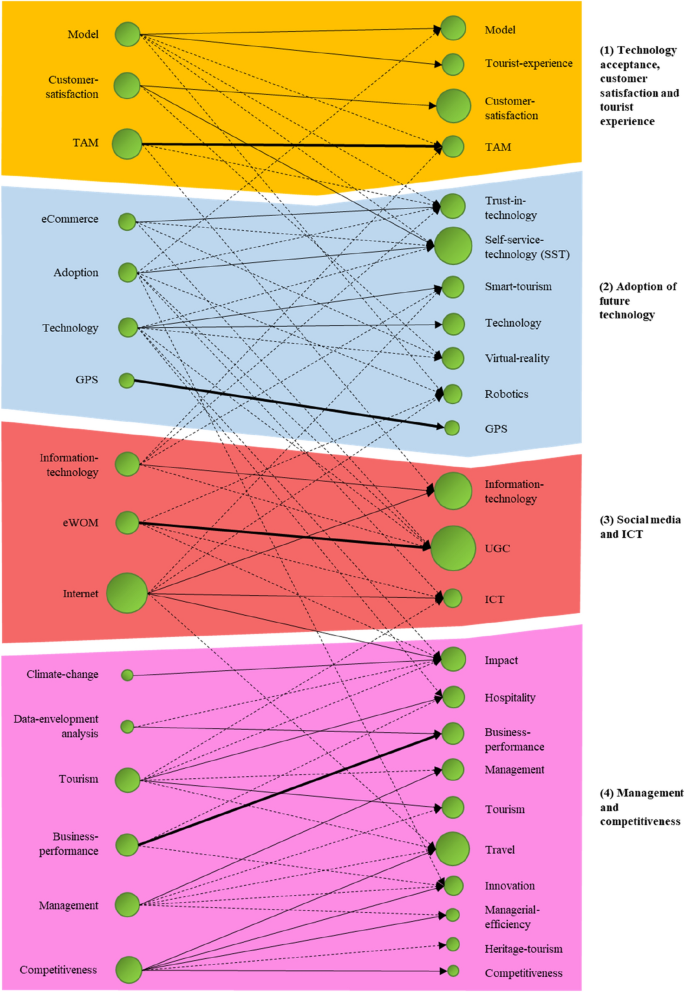Abstract
Technology and information and communication technology (ICT) have been gaining importance in tourism and hospitality with a booming research interest during the last years and specifically recently due to the disruptions of the COVID-19 crisis. Hence it is useful to structure the existing knowledge in this field to better guide directions for future research. To that end, this study synthesizes the academic literature about ‘technology and ICT’ in tourism and hospitality by carrying out a bibliometric analysis. The study identified 2424 documents, including the words ‘technolog*’ and/or ‘ICT’ combined with ‘touris*’, ‘hospitality’, ‘hotel’, and/or ‘travel’ that were published in the period 1988–2021 and collected from tourism and hospitality journals indexed in the Web of Science (WOS) and SCOPUS databases. The analysis was carried out by using SciMAT software, which offers different bibliometric tools and methods in order to achieve consistent results through a keyword co-occurrence analysis and an evolution map. The findings revealed the major research themes, including technology acceptance model, electronic word-of-mouth, user-generated content, self-services technologies, robotics, smart tourism, virtual reality, and trust in technology. The study concludes by identifying and discussing a future research agenda.
Similar content being viewed by others
1 Introduction
Technology and ICTs have transformed society, the way services are provided, and so, tourism and hospitality (Zaidan 2017; Egger et al. 2020; Gössling 2021). The development of the internet in the 1990s (Buhalis 1998) and the subsequent evolution of websites, social networks, and smartphones have facilitated greater accessibility and generation of tourism content by the users (Hannam et al. 2014; Sigala 2015), which in turn revolutionized the way tourists dream, plan, book and experience their trips as well as they disrupted and disintermediated the tourism value chain (Foris et al. 2020; Sigala 2018). Technology has now become a vital part of competitiveness, distribution, and marketing in tourism organizations (Law et al. 2009; Xiang et al. 2021). As technology continues to evolve, emerging technologies [such as the Internet of Things (IoT), Artificial Intelligence, Blockchain, Big Data, Location Based Services or Virtual and Augmented Reality Systems] continue to boost innovation and disruption in tourism and hospitality (Stankov and Gretzel 2020; Valeri and Baggio 2021). Recently, COVID-19 accelerated technology adoption, while ICTs are advocated as necessary for re-starting and rebuilding the tourism and hospitality industries (Sigala 2020).
Indeed, the importance of technologies and ICT in tourism and hospitality has attracted great research interest generating numerous publications (e.g., MacKay and Vogt 2012; Law et al. 2013; Law et al. 2014; Ivars-Baidal et al. 2019; Law et al. 2019; Xiang et al. 2021). However, when reviewing the most relevant review analyses in the tourism and hospitality literature (see Table 1), we can observe several limitations. First, there is a lack of a comprehensive view of research examining technology and ICTs in tourism and hospitality, which is essential for guiding future research agendas and directions. Second, most of the review studies are about a specific technology, area, or journal (e.g., website, social media, virtual reality, restaurants, hotels, etc.). Third, most studies develop qualitative than quantitative reviews. In addition, understanding the complexities and relationships between the research topics will allow us to further enhance the required transformations in technologies and ICTs in order to achieve an appropriate and socially constructive use in tourism and hospitality (Gössling 2021). Therefore, it is necessary to structure and synthesize our current knowledge about technology and ICT quantitatively to develop a future research agenda that can help us advance research and progress scientific debates. To that end, this study used bibliometric tools to achieve an objective synthesis of the literature (Donthu et al. 2021a; Zupic and Čater 2015) and to identify the critical research areas for future research (Samiee and Chabowski 2012).
Bibliometric analysis is a very useful tool for successfully synthesizing large amounts of information (Donthu et al. 2021a; Zupic and Čater 2015). These studies are based on statistical and mathematical techniques (Pritchard 1969) and allow to analyze the productivity and quality of scientific production (Koseoglu et al. 2016). Bibliometric analysis has become a very popular and powerful method to study the evolution and the structure of scientific knowledge produced within many disciplines (including tourism), academic journals, and scientific concepts (Sigala et al. 2021). In this study, we adopted the co-word analysis based on the frequency of the co-occurrence of keywords, because it can provide new insights about research topics.
Specifically, we look at the following research questions (RQs) with respect to technology and ICT research (in this paper, we use the words ‘technology’ and ‘ICT’ because they are the keywords used in the search to identify the documents and conceptualize this research):
RQ1: What are the major research topics of past research? How do they connect with each other?
RQ2: Which are the leading topics based on the number of citations?
RQ3: How has the research field evolved? What topics do they emerge for further research?
Overall, this study also adopts a bibliometric analysis for investigating the intellectual structure of scientific knowledge published in the field of technology and ICT in tourism and hospitality. First, we want to generate a holistic overview of this research field by identifying the themes, their size, and the relationships between them. Second, it is essential to investigate the relative importance of each theme, for instance, through the number of citations. Finally, this analysis also provides an insight about how research has evolved and how it should evolve in the future.
The paper is structured as follows. First, a brief literature review is conducted, providing a general background about technology and ICT in tourism and hospitality as well as about the role and use of bibliometric analysis. The paper continues by presenting the study’s bibliometric methodology, including the process, dataset, and analytical tools that were used. The following sections present the main results organized into two periods and with a content analysis showing the evolution of technology and ICT in tourism and hospitality between the two periods. Finally, the study concludes by proposing a future research agenda.
2 Literature review
2.1 Technology and ICT in tourism and hospitality
Technology and ICT play essential roles in tourism and hospitality and involve significant challenges and business opportunities (Law et al. 2014; Gonzalez et al. 2019; Stankov et al. 2019). The internet has revolutionized tourism for both providers and consumers (Standing et al. 2014; Lama et al. 2020), contributing to the expansion of e-tourism and its future transformation, based on six pillars, namely historicity, reflexivity, transparency, equity, plurality, and creativity (Gretzel et al. 2020). E-tourism consists of the application of ICTs in tourism (Buhalis 2003), specifically “offering travel-related services remotely to the prospective travelers, where they can transact as and when required” (Singh and Bashar 2021, p 2516). Consequently, tourism companies and destinations have been forced to use innovative methods and ICT solutions to facilitate e-tourism, maintain their business, and improve competitiveness (Neidhardt and Werthner 2018; Valeri and Baggio 2021; Buhalis 2022). In this line, Berné et al. (2015) found a cause-effect relationship between the increasing use of ICT by intermediaries in the sector and business performance. Kumar and Kumar (2020) also demonstrated that through improvements in the quality and coverage of technological structures, destinations could achieve efficiency gains in the tourism sector. Furthermore, ICT development has also affected the operational and strategic management of tourism businesses, with restructuring taking place due to the increased reliance on ICT in the processes and management of the businesses (Law et al. 2014).
In the tourism and hospitality industries, investment in technological systems and websites is vital, not only for promoting and distributing tourism services but also for obtaining customer knowledge (Hua 2020; Bastidas-Manzano et al. 2021). The use of these technologies is key in enabling consumers and service providers to communicate fluently with each other (Law et al. 2014), also giving place to the co-creation of value for stakeholders (Buhalis 2019) and the co-creation of tourism experiences (Huang et al. 2019). Interactions take place when tourists are willing to engage with destinations, hotels, or firms in general (Buhalis 2019). Furthermore, Kumar and Kumar (2020) empirically demonstrate a significant connection between ICT and tourism demand in the most prominent tourism destinations, including China, France, Germany, Italy, Mexico, Russia, Spain, the United States, and the United Kingdom.
However, despite knowing the importance of ICT, the development of technological systems should be examined carefully, as the positive results of investment in ICT capabilities occur in a different timeframe for each action and the impact of tourism enterprises’ investment in technological systems is not immediate (Hua 2020). Moreover, these technologies have an added challenge: the speed at which changes occur. This means that companies cannot develop strategies based on technology and online communication in the long term and must develop dynamic innovation strategies based on personal knowledge (Munar 2012; Valeri and Baggio 2021).
Technological developments have also enabled disintermediation in tourism by connecting suppliers with customers direct (Zaidan 2017). As a result, multiple tools such as destination marketing systems (DMS), global distribution systems (GDS), and computer reservation systems (CRS) were developed several years ago, and new electronic intermediaries emerged (Fuchs et al. 2010). However, this has brought a significant challenge for traditional tourism intermediaries, many of them small and medium-sized enterprises that cannot invest a large number of resources in developing new technology-based systems (Lin 2016). To mitigate this impact, it was essential for intermediaries to create strong relationships and agreements with the other parts of the distribution channels, especially with tourism organizations and suppliers, in order to improve their market position and not disappear due to the emergence of other online intermediaries (Berné et al. 2015). In addition, these intermediaries can rely on application service providers, external information providers with whom they can benefit from new technologies at a lower cost than developing their own systems (Lin 2016). The adoption of ICT and technological innovations by the tourism is vital for the industry’s future and so, understanding the drivers and obstacles of technology adoption is also vital (Buhalis 2019). Understanding technological development and adoption is also critical as it transforms the processes and relationships between tourism suppliers and tourists and affects tourism competitiveness.
2.2 Bibliometric analysis
The bibliometrics concept was developed by Pritchard (1969, p. 349) to encompass “the application of mathematics and statistical methods for books and other media”. Bibliometrics is a tool that facilitates the evaluation and study of the evolution of studied topics through statistical techniques, thus enabling the evaluation and analysis of academic quality and productivity (Koseoglu et al. 2016). Bibliometrics also helps to analyze a field through big datasets (Callon et al. 1991; Coulter et al. 1998; Valenzuela et al. 2017), making it possible to achieve greater objectivity in literature studies when bibliometric methods are applied correctly (Zupic and Čater 2015; Donthu et al. 2021b).
Bibliometrics draws on information such as concepts, author names, journals, or references provided by studies published daily. It is a tool that assists researchers by providing them with a synthesis of previous studies that allows them to base their opinion on aggregate views on the topics under analysis (Zupic and Čater 2015). The results of the bibliometric analysis provide guidance for future lines of research (Samiee and Chabowski 2012). It is also helpful for journal editors, as it facilitates the analysis of the productivity of publications and thus helps them to make decisions about new publications (Zupic and Čater 2015). Therefore, a significant number of bibliometric studies have been carried out for different purposes, such as identifying the most prolific academics or institutions, classifying knowledge by periods or geographical areas, or identifying the level of maturity of specific topics (Koseoglu et al. 2016; Sigala et al. 2021).
In addition, bibliometric analysis has been applied in several disciplines and particular journals. Specifically, topics related to consumer, services, business, innovation, and social media have been studied. The number of bibliometric studies in tourism and hospitality has been increasing significantly since 2008 (Sigala et al. 2021). Some recent works, such as Kim and So (2022) about customer experience in hospitality and tourism, Nusair et al. (2019) about social media in hospitality and tourism; Shin and Perdue (2019) about self-service technology in hospitality; Palácios et al. (2021) about trust in hospitality and tourism; or Sigala et al. (2021) applied to the Journal of Hospitality and Tourism Management are some among many examples. This interest has gone hand in hand with an increase in the number of academic journals in the fields of tourism and hospitality in the WOS and SCOPUS databases. Furthermore, due to the growing importance of new technologies and ICT in tourism and hospitality, many researchers have conducted bibliometric studies on some topic-specific issues, such as the study by Leung et al. (2015) on tourism marketing via the internet, or the studies shown in Table 1. However, there is no bibliometric analysis focusing on the general analysis of technology and ICT in tourism and hospitality using a quantitative approach so far. Therefore, this study attempts to summarize our existing knowledge on this topic by examining the structure and the evolution of current knowledge. The study also contributes to the field by suggesting a future research agenda and directions that can progress existing knowledge.
3 Bibliometric methodology
Bibliometrics offers multiple tools and methods to achieve the objective of this work, which is to synthesize and analyze the scientific production of technology and ICT in tourism and hospitality journals. In this paper, we have defined the research methodology following the studies of Donthu et al. (2021a), Paul and Rialp (2020), and Zupic and Čater (2015). We selected the domain-based review in our research, because it is prevalent in areas related to business, marketing, or management, among others. This type of review can be classified into the next categories: structured review, framework-based, bibliometric review, hybrid-narrative, and review aiming for model/framework development (Paul and Rialp 2020). After that, we used a hybrid type review, combining the method of bibliometric and content analysis. The first one is used to analyze an extensive amount of published research by using statistical tools, and the second one is used to summarize the content (major themes) of the literature and discover future research gaps. Specifically, in this study, bibliometric methods have been used to obtain a descriptive analysis of performance of the scientific production, and the science mapping. Science mapping is a process that requires the next steps: research design, compiling the bibliometric data, analysis, visualization, and interpretation.
The first step has been to define the research questions to be answered in the study and to select the most appropriate bibliometric methods to answer these questions. We selected the co-word analysis, because it allows us to evaluate the topics that have attracted the most attention in academia and, consequently, the most important themes for the research domain (Callon et al. 1991). Then, we selected the WOS and SCOPUS databases as comprehensive databases for international tourism and hospitality publications and in order to increase the reliability of the findings. The software SciMAT was selected because, in addition to the network analysis, we can highlight the longitudinal analysis as a benefit versus other software (Cobo et al. 2012). Finally, it appeared that the best way to achieve the objective of the study was to adopt a keyword analysis, as this is the most appropriate method for identifying co-occurrence of words. This is also found as a very useful method in social sciences, because it provides a map grouping the terms of the field of study (Marshakova-Shaikevich 2005).
Relative to the descriptive analysis of performance, it is essential to locate the relevant information due to the multiple possibilities offered by bibliographic databases. In this study, to develop the descriptive analysis, we used the tools offered by the WOS and SCOPUS to filter documents. Specifically, these databases offer the possibility of grouping documents by year of publication, sources, countries, institutions, etc., but for this study, only the most relevant descriptive information has been considered.
3.1 Dataset and standardization
The data used to perform the bibliometric analysis of this study was downloaded from the WOS and SCOPUS databases for the period 1988–2021. In order to obtain quality data, the search was carried out by defining some criteria that delimit the area of interest of the study, following the proposal of Xiang et al. (2021) by extending information technology in tourism to social sciences. The specific search carried out was a thematic search for the topics “technolog*” and “ICT” together with the terms “touris*” or “hospitality” or “hotel” or “travel”, and it was reasoned in an attempt to cover the main publications in the domain. In this point, we should highlight that we tried several searches, and finally, the option with the broad terms “technolog*” and “ICT” was more accurate. There are two alternatives to make the search: using a high number of keywords could be an alternative (Leung et al. 2017); or a more concentrated search on a very few words with direct relation to the exact research topic (Leung et al. 2013; Zeng and Gerritsen 2014). Both alternatives were tested. The first search that we tried included more than 15 words (e.g., e-Tourism, e-Business, smart tourism, robotics, website, social media, etc.). In the second search, following the work of Leung et al. (2013) and Zeng and Gerritsen (2014), the search list was narrowed down to the following words: the terms “technolog*” and “ICT” combined with “touris*”, “hospitality”, “travel”, and “hotel”. We compare the findings and this search leads us to obtain publications related to “e-Tourism”, “smart tourism”, “robotics”, “website”, etc., and also publications related to technology and ICT in tourism and hospitality in general. Finally, we decided to use the last alternative. Nonetheless, we are aware of a need to recognize that there is a current discussion on two alternatives and the final decision depending on the findings.
We refined the search using the following filters. First, we filtered the results by selecting research articles (including research notes), review articles, and early access. Conference papers and book reviews were not included. Second, we selected papers in the English language. Third, we selected the journals into the category ‘Hospitality, Leisure, Sport and Tourism’ in both databases. Finally, we covered the databases’ whole period, and the first publication appeared in 1988. Many papers were duplicated in both databases. After revising no related articles and deleting duplicates, a total of 2424 were obtained and then exported to the software SciMAT (Cobo et al. 2012; https://sci2s.ugr.es/scimat/), and it generated 8132 keywords. Figure 1 offers the details of the process to obtain and analyze the information in this bibliometric analysis. The next step is to standardize those words with the same or similar meaning. First, we used an automated term grouping by singular and plurals and another based on distances, detecting terms that differ by a distance of X characters. Second, a laborious process of manually grouping terms was carried out. To do this, the terms have been sorted in alphabetical order, and the search engine has been used to locate those words with similar meanings and reduce the number of concepts. In addition, in such cases where it was not certain that they meant the same thing, it was confirmed by reading the articles to really check that they could be grouped under a single term. This action allows both adding terms to existing groups and creating new groups that encompass the words in the group. For example, ‘ease of use’, ‘perceived ease of use’, and ‘perceived ease’ were grouped under a single concept. The objective is to create groups of words having similar meanings. Once this process ended, we obtained 6299-word groups. The next step is related to the periods to offer a longitudinal analysis. It is possible to specify a cut-off point when there is an extensive dataset, and the recommendation is to find a potential event that caused key changes in the research themes between the first and second periods. In this sense, in our study, we can observe the increase in the number of systematic literature reviews about technology issues from 2017. Thus, the periods were defined as 1988–2016 and 2017–2021.
3.2 Analytical tools and process
SciMAT generates two types of outputs (Cobo et al. 2012): (1) performance analysis, which refers to the impact of a research theme through the number of publications (as an indicator of the productivity of the author or theme) and citations (as the influence of the author or theme within the scientific community) (Fetscherin and Heinrich, 2015; Merigó and Yang, 2017); and (2) science mapping analysis, which creates a graphic representation of the structure of research (strategic diagrams and cluster networks) and its evolution over time (Cobo et al. 2012). The strategic diagram is a two-dimensional map (four quadrants) built considering two parameters (Callon et al. 1991; Cobo et al. 2011): centrality and density (see Fig. 2). The science mapping analysis is based on the co-occurrence of the keywords, and it has been considered adequate for the purpose of this study. Specifically, the aim is to develop a co-occurrence analysis to synthesize documents (Callon et al. 1991). In this way, it is possible to locate relationships between terms since co-occurrence occurs when two terms appear in the same document (Cobo et al. 2011). This analysis enables the representation of the relationship and its strength between the different concepts through maps. In these graphic representations, keywords are represented as nodes and appear related when they are in the same documents (Cobo et al. 2011). In addition, following Cobo et al. (2012), we summarize the four analysis phases of the bibliometric method used in this study in Fig. 2 detection of research themes, visualization of research topics through strategic diagrams and thematic networks, the discovery of thematic areas and their evolutions, and performance analysis (see Fig. 2).
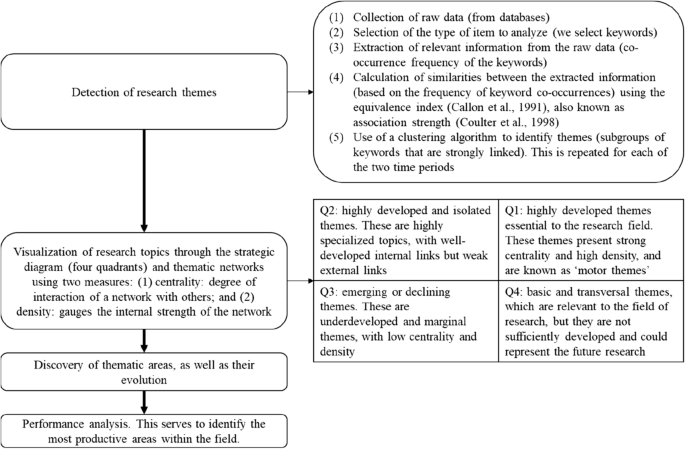
Source: Adapted from Cobo et al. (2012)
Phases of bibliometric method and science mapping analysis.
3.3 Analysis with SciMAT
Once the data had been imported into the software, the aim of the pre-processing was to unify the similar words under a single concept as well as to solve the small errors in the imported data, and the periods have been created, the analysis with SciMAT is executed. The process of analysis with SciMAt is as follows (Cobo et al. 2012).
-
1.
Selection of the periods. This step consists of indicating the periods to be analyzed. For the study, the two periods have been selected.
-
2.
Selection of the unit of analysis. This step is essential, as it defines which aspect of the field is the object of the study. Thus, as this is conceptual research, the unit of analysis selected is the keywords that have been previously pre-processed.
-
3.
Data reduction. The aim of this step is to consider the most important information to achieve more precise results. A minimum frequency value of 4 has been established, which means that only those concepts that appear in at least four publications will be considered in the analysis.
-
4.
Selection of the type of matrix. As explained above, co-occurrence has been considered to be the most appropriate algorithm to achieve the purpose of the study.
-
5.
Network reduction. In this step, a certain limit is selected to consider the strongest or most significant links and to eliminate the less relevant ones. A minimum value of four has been considered; that is, a relationship between two concepts must appear together in at least four documents.
-
6.
Normalization. In this step, the similarity measure of the analysis is selected from the different possibilities offered by the program. The one considered most appropriate for the study is the equivalence index, which is used to relativize the relationships between the keywords since it measures their strength.
-
7.
Clustering algorithm. Clustering algorithms are a key element in the construction of scientific maps. For the present study, the simple center algorithm has been used. This tool clusters the data in a way that allows generating the desired networks of related words (maximum and minimum network size: 12 and 3, respectively).
-
8.
Document mapper. In this step, the software groups the documents according to the user’s selection. For this study, it has been selected the collection of core documents and the union mapper, which incorporates those documents that have at least one element in common with the cluster.
-
9.
Quality measures. The total of citations and the h-index have been selected as bibliometric indicators that evaluate performance. These indicators complement other performance measures automatically provided by SciMAT, such as the number of documents.
-
10.
Longitudinal. This step is necessary to complete the analysis. Jaccard’s index and inclusion index are selected to carry out a longitudinal analysis.
-
11.
Make analysis. Once the previously mentioned steps have been completed, the results are graphically represented to be analyzed and interpreted, leading to the main conclusions of the study.
4 Results
4.1 Data pre-processing
Once all the documents have been loaded into SciMAT, we carried out the data pre-processing explained in the methodology section to improve the quality of the data. The first step consists of the automatic grouping “find similar words by the plural”. With this action, it has been possible to go from the initial 8132 concepts to 7731. Furthermore, in this initial step, to achieve greater rigor, words or symbols that the program included as concepts and did not provide useful information have also been deleted. The next step is the manual grouping of terms as we also indicated the methodology section. Through this manual grouping, it has been possible to reduce the number of word groups from 7731 to 6299. This reduction not only reduces the number of data to be analyzed but also improves the accuracy of the analysis and gives more reliable results.
4.2 Results analysis
This section presents the analysis of the 2424 publications. First, a descriptive analysis based on bibliometric performance indicators is presented. The bibliometric performance indicators used for the analysis are the next: the number of publications per year, the most productive journals in the field, and the most cited papers. On the other hand, a strategic map and some parameters such as the number of documents, the citations, the h-index, the centrality, the density, and some keyword networks are presented to analyze the most outstanding topics in this field. Additionally, a structural analysis of the evolution of technology and ICT in tourism and hospitality is also presented.
4.2.1 Descriptive analysis based on bibliometric performance indicators
Firstly, an analysis of the number of papers published per year has been carried out to measure the evolution over time of the productivity of publications in this field of research. Figure 3 shows a remarkable growth in the number of articles published in the period 1988–2021, highlighting the exponential growth of the last five years. It fluctuates from 1 in 1988 to 25 in 2005, to 162 in 2016, and 416 in 2020. There are 299 articles in 2021 when the authors close the analysis at the beginning of November 2021. This growth in the number of publications is related to the increase in the use of new technologies and their application to tourism, which is discussed in the next sections.
There is a great variety of journals that have contributed to this field (Table 2), which reflects the inter-disciplinary role, impact, and diffusion of technologies and ICT in tourism and hospitality. The most productive journals are Tourism Management, Journal of Hospitality and Tourism Technology, and International Journal of Contemporary Hospitality Management, with 184, 148, and 147 papers, respectively. Another critical question is to identify the leading journals in the field in terms of the number of citations per document. In this case, the top three journals taking into account the average of citations per publication are: Tourism Management (99 citations per document), Annals of Tourism Research (58 citations per document), and Journal of Travel Research (47 citations per document).
On the other hand, concerning the most cited papers (Table 3), it is worth noting that among the ten most cited papers, 7 of them have been published in the journal Tourism Management, making this journal not only the leader in terms of the number of papers published in the field but also in terms of their popularity. The most cited paper also belongs to this journal, and it is Dimitrios Buhalis and Rob Law’ paper on the state of e-Tourism research, which has been cited almost 1500 times.
4.2.2 Science mapping analysis of technology and ICT in tourism and hospitality
Through the analysis of the conceptual structure carried out in SciMAT, we will discover the thematic areas in both periods. We identified the themes located in the strategic diagrams and cluster networks for each period. On the one hand, the themes are located in one of four quadrants depending on centrality, which measures the degree of interaction of a network with others, and density, which gauges the internal strength of the network. Both oscillate between 0 and 1. On the other hand, the thematic or cluster network represents a theme and its connections with other topics based on the co-occurrence of the keywords. The most relevant keyword is at the center of the network. The volume of the sphere is related to the number of articles, and the thickness of the link between two keywords represents the association strength (see all the cluster networks in the Appendix). In order to complete the analysis, Table 4 presents the themes ordered by quadrants, and the main performance indicators for each theme are detailed: centrality range, density range, number of documents, number of citations, and h-index.
4.2.2.1 The emerging period (1988–2016)
Sixteen themes emerge from the SciMAT analysis. The internet has the largest number of documents (108), followed by the technology acceptance model (73), competitiveness (71), and customer satisfaction (70). Two of them are motor themes (technology acceptance model and customer satisfaction) together with e-WOM (52) and adoption (40) (see the top right quadrant of Fig. 4). The performance measures indicate that the internet and e-WOM were the most relevant themes by the number of citations, with 5993 and 7206 citations and h-index of 39 and 32, respectively (see Table 4).
The cluster network of technology acceptance model shows that it has been analyzed from different perspectives, such as online travel shopping or mobile hotel booking (see the Appendix). Amaro and Duarte (2015) examine online travel shopping and integrate several theoretical models providing advances such as the essential role that perceived risk plays in purchasing travel online. In this sense, they recommend effective ways to reduce perceived risk to enhance willingness to purchase travel online. In addition, Ozturk et al. (2016) find that the utilitarian value of mobile hotel booking is more important than the hedonic value in relation to usage intentions.
Several themes related to customer satisfaction appear in the cluster network: service quality, commitment, or customer loyalty. The study of Kim et al. (2011) covered a gap in tourism e-commerce, developing a theoretical model that incorporates trust and satisfaction and their effects on customer loyalty. Several studies conclude that satisfaction is very significant to increase purchase intention of tourism products online (e.g., Bai et al. 2008).
e-WOM has been analyzed since social media, user-generated content (UGC), online review, or credibility. e-WOM is one of the most important information sources in the hospitality and tourism industry because consumers cannot evaluate the tourism services prior to their consumption (e.g., Litvin et al. 2008). In the context of online reviews, Filieri and McLeay (2014) identify the antecedents of online reviews adoption, such as information quantity and product ranking. In general, travelers use UGC websites to search for travel information that other consumers have taken because they trust information posted by other travelers more than information from service providers (Herrero et al. 2015). For this reason, the analysis of information credibility is a major concern in the online tourism and hospitality industry due to travelers seeking information from various social media platforms, and previous research tries to understand how travelers respond to online reviews and analyze their credibility (e.g., Ayeh et al. 2013; Casalo et al. 2015).
Finally, adoption, as the last motor theme, presents links with smartphone, mobile apps, mobile commerce, computer technology, e-services, etc. Adoption has been defined as the extent to which consumers modify their behavior by utilizing information technology (Filieri and McLeay 2014). The technology adoption model has been studied many times in the context of the tourism and hospitality industry in order to examine the predictors of mobile app use among tourists. For instance, smartphone self-efficacy has been considered as a critical component in tourism and travel app design (e.g., Lu et al. 2015; Okumus and Bilgihan 2014).
In the second quadrant, themes that have well-developed internal but weak external links emerged (see the top left quadrant in Fig. 4): business performance, e-commerce, GPS, climate change, and data envelopment analysis. Their cluster networks results showed that business performance had been analyzed in the hotel industry, and it connects mainly to technological innovation, green technology, or product innovation. E-commerce has been studied in the context of technology and e-business adoption, trust in technology, and analyzing the purchase intention. Bilgihan et al. (2014) conclude that successful e-commerce strategies must be associated with the creation and management of customer experience, which in turn leads to purchase intention, and loyalty. GPS links to tracking technologies (e.g., Spangenberg 2014); climate change has taken into consideration the aviation industry and the ski tourism; and envelopment data analysis links to technical efficiency and productivity (we have included the figures of the cluster networks in the Appendix due to space reasons).
The third quadrant includes the next themes (bottom left of Fig. 4): management, technology, and tourism, which is between the third and fourth quadrant. These themes can be considered as less developed, and some of them could emerge in the second period due to their position in the strategic diagram. Management presents links with destination, sustainability, crisis management, co-creation, or growth, among others. In this context, Piccoli (2008) underlines information technology can provide firms with a sustained competitive advantage in the tourism and hospitality industry. Technology has been studied from smart tourism or food service perspectives related to mobile devices. Some authors point out that the birth of smart tourism happened when destinations considered new technologies involving tourists as active co-creators of their own experiences (e.g., Buonincontri and Micera 2016). The third theme is tourism which presents links with promotion technologies, destination image, small business, or qualitative research, among others. An excellent example of the use of promotion technologies is the study of Digiorgio (2016), who analyzes the relationship between promotional tools and the percentage of bookings received through three different channels (online travel agencies, digital channels, and direct channels).
Finally, the fourth quadrant (bottom right of Fig. 4) also presents central themes like in the first quadrant (many connections) but is internally underdeveloped, so they could be considered as potential themes for the next period. The themes and their number of publications are the next: Internet (108), competitiveness (71), model (62), and information technology (61). Internet presents links with websites, ICT, online travel agencies, DMOs, consumer behavior, and segmentation, among others. The paper of Buhalis and Law (2008, p. 619) is a benchmark in the e-tourism literature because they conclude “how the Internet changed the market conditions for tourism organizations due to ICT provided new tools for tourism marketing and management”. In addition, these authors advanced that “the future of e-Tourism will be focused on consumer-centric technologies”. Competitiveness is related to knowledge management, innovation, strategy, and managerial efficiency. Model refers to e-tourism, theory of planned behavior, task technology fit, and tourist experience. Information technology has been studied considering its usage and variables such as perceived risk, social influence, and intrinsic motivation. It also includes the role of human resource management.
4.2.2.2 The expansion period (2017–2021)
The main character in the second period is the thematic diversity (twenty-four themes), with UGC and self-service technology standing out as major research topics (see Fig. 5). Analyzing these two top motor themes, we can observe that UGC has 133 publications and 2369 citations, and self-service technology has 119 publications and 1559 citations (see Table 4). UGC is linked to social media, e-WOM, online reviews, big data, Facebook, Tripadvisor, and online hotel booking, among others. In the first period, e-WOM was the central theme, and it was related to UGC; however, in the second one, UGC is the central theme. Social media tools such as Facebook and Tripadvisor have been used in the second period of research to examine how hotels and destinations are using them as a marketing tool, how consumers interact, and how tourists’ online engagement has evolved in the hospitality industry (e.g., Gálvez-Rodríguez et al. 2020; Gruss et al. 2020; Molina et al. 2020) or its influence on attitudes and behavioral intentions (e.g., Sharif and Mura 2019). The recent paper of Chen et al. (2021) provides an assessment of the links between social media and big data by examining technologies and different social media platforms. Analyzing the cluster network of self-service technology, we can observe that it is linked to hotels and restaurants, service-dominant logic and value co-creation, adoption, and behavioral intention, among others. Wei et al. (2017) analyze the impact of self-service technologies on consumers’ service experience. Liu et al. (2020) examine the usage process of self-service technologies in hotels into three stages: adoption, implementation, and acceptance. Liu and Hung (2020) investigate the role of self-service technology compared with service employees in hotels.
Other motor themes ordered by the number of publications are the next: customer satisfaction (98), trust in technology (78), business performance (54), and robotics (54) (top right quadrant of Fig. 5). The cluster networks (see the Appendix) display the subsequent findings. Related to customer satisfaction, we can observe the relevance of service quality, service experience, customer loyalty, and technology readiness. Hailey Shin et al. (2021) examine the relationship between travelers’ technology readiness and satisfaction, and loyalty. Trust in technology presents links to the online environment such as e-commerce, sharing economy, technology continuance intention, or Airbnb (e.g., Nathan et al. 2020). Research offers evidence of the importance of trust in tourism e-commerce and m-commerce, suggesting that tourism and hospitality firms can benefit by targeting marketing campaigns that emphasize elements that are affected by trust (e.g., Falcao et al. 2019). Business performance links to data envelopment analysis, technical efficiency, IT capabilities, CRM, or market orientation. Data envelopment analysis has been useful to determine the drivers of tourism growth and achieving sustainable tourism development, finding some essential components in this process: technological efficiency, technology gap effect, technological progress, among others (e.g., Zha et al. 2020). Related to CRM in the tourism and hospitality industry, the literature suggests that the implementation of a successful CRM program requires a combination of people, processes, and technology (e.g., Law et al. 2018a, b). Tourism literature also explains the role of market orientation in tourism firms for marketing purposes (e.g., Herrero et al. 2018). Finally, robotics links to e-services, artificial intelligence, automation, or future tourism, among others. In this line, the recent review of Gaur et al. (2021) sheds light on future tourism, examining the role of artificial intelligence and robotics in hotels. They consider that “the service automation with service robots’ could boost hotel competitiveness” (Gaur et al. 2021, p. 4093). In addition, it is essential to understand the consumers’ perceptions and experiences with the robots’ contactless services and to be aware that artificial intelligence and automation technologies are transforming tourism services as we know them (Webster and Ivanov 2020).
Seven themes emerged in the second quadrant (top left in Fig. 5). These themes ordered by the number of documents are the next: TAM (82), smart tourism (69), virtual reality (47), GPS (32), managerial efficiency (16), heritage tourism (10), and competitiveness (9). The themes in the second quadrant include highly developed, isolated, and highly specialized topics with high internal links but weak external links with other topics. In this analysis, we can highlight smart tourism and virtual reality. Since the first relevant research on smart tourism (e.g., Gretzel et al. 2015), there has been a very extensive development in this field corresponding with the second period (e.g., Jovicic 2019; Nam et al. 2021). There has been a transformation of e-tourism into smart tourism due to the intensive adoption of ICT, the interaction with stakeholders, and decisions based on big data (Femenia-Serra and Ivars-Baidal 2021). The relevance of virtual reality in tourism could be comparable with the importance of social media, and the analysis of the understanding of the factors that affect the consumers’ perceptions is vital (e.g., Lo and Cheng 2020).
The third quadrant (bottom left in Fig. 5) reveals four underdeveloped themes, which include ordered by the number of articles: management (70), technology (60), tourist experience (58), and tourism (47). These themes are potentially emerging or disappearing themes. Management presents links with smart-hotel (e.g., Wu and Cheng 2018); the cluster network of technology presents links with service encounters, human–machine interaction, or hospitality technology (e.g., Yang et al. 2021). Tourist experience is related to emotions, involvement, or identity, among other aspects (e.g., Leung and Wen 2021). Tourism has been studied from different perspectives (state, educational, advertising, etc.).
Finally, the fourth quadrant (bottom right in Fig. 5) shows the central themes in the research field that are weakly developed. They include, ordered by the number of articles: information technology (106), travel (96), model (78), impact (70), hospitality (59), innovation (53), and ICT (44). These themes share links with other topics in the analysis. For instance, the cluster network of information technology presents a variety of topics such as the internet, virtual communities, hotel websites, and the theory of reasoned action, among others (e.g., Purohit and Thakar 2019; Zhou et al. 2021). Travel relates to computer technology, destination image, or consumer behavior. The links of model are focused on the analysis of usability, value, and preferences of mobile technology (e.g., Law et al. 2018a, b). In this period, it also analyzes the impact of digital channels or the pricing (Styvén and Wallström, 2019). Hospitality, innovation and ICT share the links with themes related to digital technology.
4.2.2.3 Structural analysis of the evolution of ‘technology and ICT in tourism and hospitality’ research with SciMAT
SciMAT offers two maps relating to the longitudinal results: (1) overlapping map, which shows the number of keywords analyzed in each period. The number of keywords in the first period was 2922 and 4492 in the second one. Moreover, this map indicates the inclusion rate (number of keywords from the first period that maintains in the second one). In this analysis, this rate was 38% (1115 words maintained and moved to the second period), and 3377 new words were incorporated in the second period. (2) The second map is the evolution map, which provides the evolution of the themes over time, obtaining a dynamic perspective of the conceptual structure of published research on technology and ICT in hospitality and tourism. Each column represents a different period, and the lines establish the relationships between the different topics over time. Related to the lines, the following aspects should be considered (Murgado-Armenteros et al. 2015). First, the continuous lines indicate a thematic nexus since both topics share the same main item. Second, the broken lines indicate those topics related because they share specific keywords. Third, the thickness of the lines is an indicator of the inclusion rate. Fourth, the size of the spheres is proportional to the number of publications achieved by each theme.
This map was manually transformed to achieve a more synthesized arrangement of the topics, allowing for their grouping by large thematic areas (see Fig. 6). The thematic areas were: (1) modeling in technology acceptance; (2) technology innovation; (3) social media and ICT; and (4) management and competitiveness. The map also allows us to detect the existence of some themes that remain constant over time (e.g., TAM, customer satisfaction, model, technology, GPS, information technology, business performance, management, and competitiveness) and themes that emerge in the second period (e.g., tourist experience, trust in technology, self-service technology, smart tourism, virtual reality, robotics, UGC, ICT, impact, hospitality, travel, innovation, managerial efficiency, and heritage tourism). Next, the subject matter and conceptual composition of each of the four areas will be analyzed.
-
(1)
Technology acceptance, customer satisfaction, and tourist experience Technology acceptance model and customer satisfaction are highly developed themes in the first (first quadrant) period covering topics such as perceived usefulness, perceived ease of use, personal innovativeness, UTAUT, online travel shopping, mobile hotel booking, service quality, and customer loyalty. The technology acceptance models are used to explain technology acceptance in the context of tourism and hospitality. The technology acceptance model and customer satisfaction also have high centrality and density in the second period. The technology acceptance model in the second period incorporates new links such as social influence or perceived enjoyment. In the case of satisfaction, it presents new links to technology readiness, consumer innovativeness, and memorable experience. In the second period, tourist experience emerges, and it analyzes experiences with online destination platforms and their identity and authenticity.
-
(2)
Adoption of future technology In the first period, adoption is a motor theme (first quadrant), e-commerce and GPS are highly developed and isolated themes (second quadrant), and technology is configured as an emerging or declining theme (third quadrant). In the second period, GPS and technology maintain their position in the second and third quadrant, respectively; and new themes such as smart tourism, virtual reality, or robotics emerge. Adoption and e-commerce are related in the first period, and they present links with technology and e-business adoption in medium sizes enterprises and security. However, technology, in the second period, refers to service encounters, engagement, or human–machine interactions. Related to the themes that emerge in the second period, robotics is a motor theme (first quadrant), and virtual reality and smart tourism are highly developed and isolated themes (second quadrant). Robotics refers to future tourism, virtual reality incorporates interactivity and flow experience as essential topics, and smart tourism focuses on analytics, among other aspects.
-
(3)
Social media and ICT Information technology is a motor theme (first quadrant) in the first and second periods. E-WOM is also a motor theme in the first period, and the internet is a relevant theme to the field, but it is not sufficiently developed (fourth quadrant). Information technology related to intrinsic motivation, perceived risk, and social influence in the first period, and it evolves in the second one to the analysis of tourist behavior in mobile hotel booking or hotel websites and also links with virtual communities. In the first period, E-WOM related to social media, UGC, online reviews, or credibility; and in the second period, this theme evolves to UGC, which incorporates big data as an essential topic of interest. In the first period, the internet offers great potential due to its position in the fourth quadrant, and it refers to website, digital channels, online travel agencies, and ICT. However, in the second period, ICT gains centrality, and it offers growth potential due to its connections with systems, panel data, sustainable development, or mobility.
-
(4)
Management and competitiveness Management is considered as an emerging or declining theme (third quadrant) in the first and in second periods because it is an underdeveloped and marginal theme with low centrality and density. Business performance is a highly and isolated theme (second quadrant) in the first period and evolves to a motor theme (first quadrant), presenting links to online CRM or information technology capabilities. Competitiveness and tourism are considered relevant to the field, but they are not sufficiently developed (fourth quadrant), suggesting future lines of research. They evolve to travel and innovation in the second period. Competitiveness is a high and isolated theme in the second period. Its relevance is due to the analysis of the evolution of technology in the supply chain management in tourism and hospitality (e.g., principal–agent relationships). Heritage tourism emerged in the second period related to sustainability, cultural tourism, and 3D technology.
5 Future research agenda
This study offers the foundation for identifying future research gaps on technology and ICT in tourism and hospitality. We have described the evolution of the research themes in the two periods, and we have grouped them into four broader areas. Subsequently, we use these areas to discuss the future research agenda and to speculate how these themes might evolve. Specifically, future research areas should include:
-
(1)
Regarding technology acceptance, customer satisfaction, and tourist experience, issues related to modeling the tourist experience require more research (Gretzel and Stankov 2021). During the last years, we can observe that research about the technology acceptance model focused its attention on analyzing drivers such as subjective norms, perceived usefulness, perceived ease of use, personal innovativeness, or social influence. These concepts have been widely examined from a general point of view and in a broad range of literature from within the generic field and hospitality or tourism. However, although we know what factors drive technology acceptance, we still do not know a lot about which technologies generate the most customer satisfaction and/or which are the critical factors influencing tourist experience. As COVID-19 has accelerated technology adoption and enabled new tourism experiences (i.e., digital and physical experiences representing the increasing demand of tourists for blended experiences), there is currently an increasing need to understand the acceptance of these ‘new’ experiences by the post-COVID-19 tourists as well as the new context and its factors affecting the tourists’ satisfaction of such experiences. Such knowledge will be equally useful for tourism destinations and firm’s managers.
-
(2)
From the adoption of future technology perspective, more attention must be paid to the emerging new technologies and the processes and factors forming trust in these technologies. As destinations and tourism companies continuously need to use new technologies to provide better services and experiences (Hua et al. 2021), research looking into the adoption of the emerging technologies becomes very vital. As technological advances and applications in tourism and hospitality occur in increasing speed, it becomes essential to examine whether travelers seek out new and unusual new technology experiences in the same rate (Koo and Chang 2021). Based on our analyses of the two periods, it is also observed that studies in both periods heavily focus on the most heavily adopted technologies (i.e., internet in the first period and UGC and social media in the second period), ignoring and/or paying less attention to technologies that are less adopted and/or used. However, technologies such as virtual and augmented reality as well as robots and AI that have been less adopted and used in the previous period are currently having an exponential adoption rate due to the COVID-19 implications. Hence, it becomes important not only to focus on and examine the adoption and success factors of heavily used technologies but also to understand the context and the factors influencing the adoption and use of less popular technologies. Such knowledge can better help us understand how technology adoption happens and/or not happens and how context and situational factors can play an important role in the former. In addition, it would be relevant to better understand the barriers that do not favor trust in new technology, because although previous research shows that trust in technology significantly influences technology adoption, past studies also provide inconsistent findings regarding the process of forming technology trust (Hua et al. 2021).
-
(3)
Social media and ICT in future research. Based on the analysis of their cluster networks, social media and ICT could be suggesting topics for further research to face their challenges, such as ICTs are consciously used by destinations and businesses to move on specific agendas (Gössling 2021). On the one hand, social media and ICTs generate online interactions between tourists, and they could cause information myopia due to the uncertainty of the interactions and online reviews. For this reason, future studies should address the real benefits of social media and ICTs in general and in the tourism and hospitality industry. On the other hand, previous research has identified that “technological changes increasingly facilitate the concentration of power into certain platforms” (Mehraliyev et al. 2021, p.227), such as TripAdvisor, Booking, and Airbnb. As research into the field of the platform economy is currently evolving in tourism, it will be interesting for future research to investigate and challenge the ‘unquestioned’ mantra that the social media ‘empower’ the users versus the ‘platforms. Such research can also focus on the role of ‘big’ data and content in providing ‘empowerment’ and power, as data is declared as the oil of the new economy. As data has always been the lifeblood of tourism, research investigating into the role and implications of data collection, analysis, and use in tourism and hospitality becomes critically important.
-
(4)
From management and competitiveness perspectives, more research is needed to analyze the factors that contribute to tourism and hospitality competitiveness and how destinations and businesses should manage those factors. Definitions, models, and factors related to tourism competitiveness have been studied in the tourism and hospitality literature. Previous research mainly focused on tourism competitiveness or destination competitiveness from a supply-side approach, and it has shown that there are different competitiveness factors such as information or climate depending on the sector (Cronjé and du Plessis 2020). Hence, future studies should explore the demand side and analyze the opinions of tourists regarding what makes a destination competitive. For instance, there are new trends such as sustainability, responsibility, well-being, social/community value, ICTs, and smart tourism that future ICT competitiveness research should examine. COVID-19 has intensified the need to increase the sustainability and responsibility of tourism and hospitality, while the role of ICT for generating social value, sustainability, and well-being is increasing. Future studies should critically include into the operationalization and measurement of competitiveness such soft factors such as community well-being and social value and subsequently examine the role and use of ICT in achieve this type of competitiveness. As competitiveness measured solely on quantitative results such as business profits, visitors’ numbers, and reduced costs becomes obsolete, future research should be able to measure, quantify and provide evidence of the impact of ICTs in such soft constructs in tourism and hospitality. Such research knowledge is instrumental and vital in the tourism industry in order to show firms and destinations the ‘reasons’ to adopt and invest on such ICTs. In addition, as “only a few studies have tried to understand destination competitiveness from a cultural perspective” (Kumar and Dhir 2020, p.9), future studies should also investigate how national cultures and other cultural attributes influence people’s understanding on tourism competitiveness and so, their decision-making to invest on ICT to achieve the latter.
6 Conclusions, implications, and further research
This study has two major contributions to the field: (1) it synthesizes and critically analyzes research about technology and ICT in tourism and hospitality published in journals during the period 1988–2021; and (2) it provides directions for further research. In contrast to earlier studies using a qualitative approach for reviewing past literature, this study used a quantitative analysis for identifying the themes of past research and examining their contribution. Hence, this paper provides a more precise way to quantify but also visualize the structure and the evolution of our knowledge development in this field. In addition, the paper develops a future research agenda that identifies several suggestions and directions for future research. Finally, the majority of past papers reviewing the evolution of the knowledge in the field of information technology in tourism have focused on specific topics, areas, platforms, or business applications, such as smart tourism, eTourism, social media, artificial intelligence, robotics, hotels, TripAdvisor, Airbnb. On the contrary, several authors (e.g., Xiang et al. 2021) have advocated that research on this field should be advanced by studying beyond these narrow focused issues. In this vein, our research contributes to the current literature by: broadening the areas for understanding the knowledge structure and development in the field of ICT tourism and hospitality; and consequently, by identifying directions for future research that go beyond single topics such as management and competitiveness issues, such as sustainability, responsibility, well-being, and social/community value.
7 Limitations
Despite having worked to achieve a synthesis as accurately as possible of the scientific production in the field of new technologies in tourism, there are some limitations associated with bibliometric analysis. First of all, the compilation of documents may have omitted some relevant articles in the field due to the keywords used in the search. Second, there are articles with a large number of keywords and others with only a single keyword. Third, as mentioned in the methodology, some keywords are written in different ways, an effect that has been tried to alleviate through the pre-processing of the data. Therefore, despite having carried out the process conscientiously and having checked whether specific terms could really be grouped, errors may have been made, or some words may have been omitted when carrying out the grouping.
Availability of data and material (data transparency)
Not applicable.
Change history
15 July 2022
A Correction to this paper has been published: https://doi.org/10.1007/s40558-022-00230-z
References
Amaro S, Duarte P (2015) An integrative model of consumers’ intentions to purchase travel online. Tour Manage 46:64–79
Ayeh JK, Au N, Law R (2013) “Do we believe in trip advisor?” Examining credibility perceptions and online travelers’ attitude toward using user-generated content. J Travel Res 52(4):437–452
Bai B, Law R, Wen I (2008) The impact of website quality on customer satisfaction and purchase intentions: evidence from Chinese online visitors. Int J Hosp Manage 27(3):391–402
Bastidas-Manzano AB, Sánchez-Fernández J, Casado-Aranda LA (2021) The past, present, and future of smart tourism destinations: a bibliometric analysis. J Hospital Tour Res 45(3):529–552
Berné C, García-González M, García-Uceda ME, Múgica JM (2015) The effect of IT on relationship enhancement and performance in tourism channels. Tour Manage 48:188–198
Bilgihan A, Okumus F, Nusair K, Bujisic M (2014) Online experiences: flow theory, measuring online customer experience in e-commerce and managerial implications for the lodging industry. Inf Technol Tour 14(1):49–71
Buhalis D (1998) Strategic use of information technologies in the tourism industry. Tour Manage 19(5):409–421
Buhalis D (2003) eTourism: information technology for strategic tourism management. Pearson, London, UK
Buhalis D (2019) Technology in tourism-from information communication technologies to eTourism and smart tourism towards ambient intelligence tourism: a perspective article. Tour Rev 75(1):267–272
Buhalis D (2022) ETourism. In Encyclopedia of tourism management and marketing. Edward Elgar Publishing
Buhalis D, Law R (2008) Progress in information technology and tourism management: 20 years on and 10 years after the internet—the state of eTourism research. Tour Manage 29(4):609–623
Buonincontri P, Micera R (2016) The experience co-creation in smart tourism destinations: a multiple case analysis of European destinations. Inf Technol Tour 16(3):285–315
Callon M, Courtial JP, Laville F (1991) Co-word analysis as a tool for describing the network of interactions between basic and technological research: the case of polymer chemistry. Scientometrics 22(1):155–205
Casalo LV, Flavian C, Guinaliu M, Ekinci Y (2015) Do online hotel rating schemes influence booking behaviors? Int J Hosp Manag 49:28–36
Chen J, Becken S, Stantic B (2021) Harnessing social media to understand tourist mobility: the role of information technology and big data. Tour Rev (ahead-of-print)
Cobo MJ, López-Herrera AG, Herrera-Viedma E, Herrera F (2011) An approach for detecting, quantifying, and visualizing the evolution of a research field: a practical application to the fuzzy sets theory field. J Informetr 5(1):146–166
Cobo MJ, López-Herrera AG, Herrera-Viedma E, Herrera F (2012) SciMAT: A new science mapping analysis software tool. J Am Soc Inform Sci Technol 63(8):1609–1630
Coulter N, Monarch I, Konda S (1998) Software engineering as seen through its research literature: a study in co-word analysis. J Am Soc Inf Sci 49:1206–1223
Cronjé DF, du Plessis E (2020) A review on tourism destination competitiveness. J Hosp Tour Manage 45:256–265
Digiorgio V (2016) Impact of promotional tools on reservation channels management: a descriptive model of Italian accommodation facilities. Inf Technol Tour 16(4):347–373
Donthu N, Kumar S, Mukherjee D, Pandey N, Lim WM (2021a) How to conduct a bibliometric analysis: an overview and guidelines. J Bus Res 133:285–296
Donthu N, Kumar S, Ranaweera C, Sigala M, Sureka R (2021b) Journal of Service Theory & Practice at age 30: past, present and future contributions to service research. J Serv Theory Pract 31(3):265–295
Egger I, Lei SI, Wassler P (2020) Digital free tourism—an exploratory study of tourist motivations. Tour Manage 79:104098
Falcao RP, Ferreira JB, da Costa Filho MCM (2019) The influence of ubiquitous connectivity, trust, personality and generational effects on mobile tourism purchases. Inf Technol Tour 21(4):483–514
Femenia-Serra F, Ivars-Baidal JA (2021) Do smart tourism destinations really work? The case of Benidorm. Asia Pac J Tour Res 26(4):365–384
Filieri R, McLeay F (2014) E-WOM and accommodation: an analysis of the factors that influence travelers’ adoption of information from online reviews. J Travel Res 53(1):44–57
Foris D, Tecau AS, Hartescu M, Foris T (2020) Relevance of the features regarding the performance of booking websites. Tour Econ 26(6):1021–1041
Fuchs M, Höpken W, Föger A, Kunz M (2010) E-business readiness, intensity, and impact: an Austrian destination management organization study. J Travel Res 49(2):165–178
Gálvez-Rodríguez MM, Alonso-Cañadas J, Haro-de-Rosario A, Caba-Pérez C (2020) Exploring best practices for online engagement via Facebook with local destination management organisations (DMOs) in Europe: a longitudinal analysis. Tour Manage Perspect 34:100636
Gaur L, Afaq A, Singh G, Dwivedi YK (2021) Role of artificial intelligence and robotics to foster the touchless travel during a pandemic: a review and research agenda. Int J Contemp Hosp Manage 33(11):4079–4098
Gonzalez R, Gasco J, Llopis J (2019) ICTs in hotel management: a research review. Int J Contemp Hosp Manage 31(9):3583–3609
Gössling S (2021) Tourism, technology and ICT: a critical review of affordances and concessions. J Sustain Tour 29(5):733–750
Gretzel U, Stankov U (2021) ICTs and well-being: challenges and opportunities for tourism. Inf Technol Tour 23:1–4
Gretzel U, Sigala M, Xiang Z, Koo C (2015) Smart tourism: foundations and developments. Electron Mark 25(3):179–188
Gretzel U, Fuchs M, Baggio R, Hoepken W, Law R, Neidhardt J, Pesonen J, Zanker M, Xiang Z (2020) e-Tourism beyond COVID-19: a call for transformative research. Inf Technol Tour 22:187–203
Gruss R, Kim E, Abrahams A (2020) Engaging restaurant customers on facebook: the power of belongingness appeals on social media. J Hospital Tour Res 44(2):201–228
Hailey Shin H, Jeong M, Cho MH (2021) The impact of smart tourism technology and domestic travelers’ technology readiness on their satisfaction and behavioral intention: a cross-country comparison. Int J Tour Res 23(5):726–742
Hannam K, Butler G, Paris CM (2014) Developments and key issues in tourism mobilities. Ann Tour Res 44:171–185
Herrero Á, San Martín H, Hernández J (2015) How online search behavior is influenced by user-generated content on review websites and hotel interactive websites. Int J Contemp Hosp Manage 27(7):1573–1597
Herrero A, San Martín H, Collado J (2018) Market orientation and SNS adoption for marketing purposes in hospitality microenterprises. J Hosp Tour Manage 34:30–40
Hua N (2020) Do information technology (IT) capabilities affect hotel competitiveness? J Hosp Tour Technol 11(3):447–460
Hua C, Cole S, Xu N (2021) Rethinking trust in tourism apps: the moderating effect of age. J Hosp Tour Technol 12(3):548–562
Huang YC, Chang LL, Yu CP, Chen J (2019) Examining an extended technology acceptance model with experience construct on hotel consumers’ adoption of mobile applications. J Hosp Market Manage 28(8):957–980
Ivars-Baidal JA, Celdrán-Bernabeu MA, Mazón JN, Perles-Ivars ÁF (2019) Smart destinations and the evolution of ITs: a new scenario for destination management? Curr Issue Tour 22(13):1581–1600
Jovicic DZ (2019) From the traditional understanding of tourism destination to the smart tourism destination. Curr Issue Tour 22(3):276–282
Kim H, So KKF (2022) Two decades of customer experience research in hospitality and tourism: a bibliometric analysis and thematic content analysis. Int J Hosp Manage 100:103082
Kim MJ, Chung N, Lee CK (2011) The effect of perceived trust on electronic commerce: shopping online for tourism products and services in South Korea. Tour Manage 32(2):256–265
Koo C, Chang Y (2021) Guest editorial: new technologies for the tourism and hospitality industry. Ind Manag Data Syst 121(6):1145–1151
Koseoglu MA, Rahimi R, Okumus F, Liu J (2016) Bibliometric studies in tourism. Ann Touris Res 61:180–198
Kumar S, Dhir A (2020) Associations between travel and tourism competitiveness and culture. J Destin Mark Manag 18:100501
Kumar N, Kumar RR (2020) Relationship between IT and international tourism demand: a study of major tourist destinations. Tour Econ 26(6):908–925
Lama S, Pradhan S, Shrestha A (2020) Exploration and implication of factors affecting e-tourism adoption in developing countries: a case of Nepal. Inf Technol Tour 22(1):5–32
Law R, Leung R, Buhalis D (2009) Information technology applications in hospitality and tourism: a review of publications from 2005 to 2007. J Travel Tour Mark 26(5–6):599–623
Law R, Leung D, Au N, Lee HA (2013) Progress and development of information technology in the hospitality industry: evidence from Cornell Hospitality Quarterly. Cornell Hospital Quart 54(1):10–24
Law R, Buhalis D, Cobanoglu C (2014) Progress on information and communication technologies in hospitality and tourism. Int J Contemp Hosp Manage 26(5):727–750
Law R, Chan ICC, Wang L (2018a) A comprehensive review of mobile technology use in hospitality and tourism. J Hosp Market Manage 27(6):626–648
Law R, Fong DKC, Chan ICC, Fong LHN (2018b) Systematic review of hospitality CRM research. Int J Contemp Hosp Manage 30(3):1686–1704
Law R, Leung D, Chan ICC (2019) Progression and development of information and communication technology research in hospitality and tourism: a state-of-the-art review. Int J Contemp Hosp Manage 32(2):511–534
Leung XY, Wen H (2021) How emotions affect restaurant digital ordering experiences: a comparison of three ordering methods. J Hosp Tour Technol 12(3):439–453
Leung D, Law R, Van Hoof H, Buhalis D (2013) Social media in tourism and hospitality: a literature review. J Travel Tour Mark 30(1–2):3–22
Leung XY, Xue L, Bai B (2015) Internet marketing research in hospitality and tourism: a review and journal preferences. Int J Contemp Hosp Manage 27(7):1556–1572
Leung XY, Sun J, Bai B (2017) Bibliometrics of social media research: a co-citation and co-word analysis. Int J Hosp Manage 66:35–45
Lin SW (2016) The critical success factors for a travel application service provider evaluation and selection by travel intermediaries. Tour Manage 56:126–141
Litvin SW, Goldsmith RE, Pan B (2008) Electronic word-of-mouth in hospitality and tourism management. Tour Manage 29(3):458–468
Liu C, Hung K (2020) A comparative study of self-service technology with service employees: a qualitative analysis of hotels in China. Inf Technol Tour 22(1):33–52
Liu C, Hung K, Wang D, Wang S (2020) Determinants of self-service technology adoption and implementation in hotels: the case of China. J Hosp Market Manage 29(6):636–661
Lo WH, Cheng KLB (2020) Does virtual reality attract visitors? The mediating effect of presence on consumer response in virtual reality tourism advertising. Inf Technol Tour 22(4):537–562
Lu J, Mao Z, Wang M, Hu L (2015) Goodbye maps, hello apps? Exploring the influential determinants of travel app adoption. Curr Issue Tour 18(11):1059–1079
MacKay K, Vogt C (2012) Information technology in everyday and vacation contexts. Ann Tour Res 39(3):1380–1401
Marshakova-Shaikevich I (2005) Bibliometric maps of field of science. Inf Process Manage 41(6):1534–1547
Mehraliyev F, Choi Y, King B (2021) Theoretical foundations of social media power in hospitality and tourism: a hierarchical model. Cornell Hospital Quart 62(2):215–231
Molina A, Gomez M, Lyon A, Aranda E, Loibl W (2020) What content to post? Evaluating the effectiveness of Facebook communications in destinations. J Destin Mark Manage 18:100498
Munar AM (2012) Social media strategies and destination management. Scand J Hosp Tour 12(2):101–120
Nam K, Dutt CS, Chathoth P, Khan MS (2021) Blockchain technology for smart city and smart tourism: latest trends and challenges. Asia Pacific J Tour Res 26(4):454–468
Nathan RJ, Victor V, Tan M, Fekete-Farkas M (2020) Tourists’ use of Airbnb app for visiting a historical city. Inf Technol Tour 22(2):217–242
Neidhardt J, Werthner H (2018) IT and tourism: still a hot topic, but do not forget IT. Inf Technol Tour 20:1–7
Nusair K, Butt I, Nikhashemi SR (2019) A bibliometric analysis of social media in hospitality and tourism research. Int J Contemp Hosp Manage 31(7):2691–2719
Okumus B, Bilgihan A (2014) Proposing a model to test smartphone users’ intention to use smart applications when ordering food in restaurants. J Hosp Tour Technol 5(1):31–49
Ozturk AB, Nusair K, Okumus F, Hua N (2016) The role of utilitarian and hedonic values on users’ continued usage intention in a mobile hotel booking environment. Int J Hosp Manage 57:106–115
Palácios H, de Almeida MH, Sousa MJ (2021) A bibliometric analysis of trust in the field of hospitality and tourism. Int J Hosp Manage 95:102944
Paul J, Rialp A (2020) The art of writing literature review: what do we know and what do we need to know? Int Bus Rev 29(4):101717
Piccoli G (2008) Information technology in hotel management: a framework for evaluating the sustainability of IT-dependent competitive advantage. Cornell Hospital Quart 49(3):282–296
Pritchard A (1969) Statistical bibliography or bibliometrics. J Document 25(4):348–349
Purohit A, Thakar U (2019) Role of information and communication technology in improving loyalty program effectiveness: a comprehensive approach and future research agenda. Inf Technol Tour 21:259–280
Samiee S, Chabowski BR (2012) Knowledge structure in international marketing: a multi-method bibliometric analysis. J Acad Mark Sci 40(2):364–386
Sharif SP, Mura P (2019) Narratives on Facebook: the impact of user-generated content on visiting attitudes, visiting intention and perceptions of destination risk. Inf Technol Tour 21(2):139–163
Shin H, Perdue RR (2019) Self-service technology research: a bibliometric co-citation visualization analysis. Int J Hosp Manage 80:101–112
Sigala M (2015) Social media marketing in tourism and hospitality. Inf Technol Tour 15:181–183
Sigala M (2018) New technologies in tourism: From multi-disciplinary to anti-disciplinary advances and trajectories. Tour Manage Perspect 25:151–155
Sigala M (2020) Tourism and COVID-19: impacts and implications for advancing and resetting industry and research. J Bus Res 117:312–321
Sigala M, Kumar S, Donthu N, Sureka R, Joshi Y (2021) A bibliometric overview of the Journal of Hospitality and Tourism Management: Research contributions and influence. J Hosp Tour Manage 47:273–288
Singh S, Bashar A (2021) A bibliometric review on the development in e-tourism research. Int Hospital Rev (ahead-of-print)
Spangenberg T (2014) Development of a mobile toolkit to support research on human mobility behavior using GPS trajectories. Inf Technol Tour 14(4):317–346
Standing C, Tang-Taye JP, Boyer M (2014) The impact of the internet in travel and tourism: a research review 2001–2010. J Travel Tour Mark 31(1):82–113
Stankov U, Gretzel U (2020) Tourism 4.0 technologies and tourist experiences: a human-centered design perspective. Inf Technol Tour 22(3):477–488
Stankov U, Filimonau V, Slivar I (2019) Calm ICT design in hotels: a critical review of applications and implications. Int J Hosp Manage 82:298–307
Styvén ME, Wallström Å (2019) Benefits and barriers for the use of digital channels among small tourism companies. Scand J Hosp Tour 19(1):27–46
Valenzuela LM, Merigó JM, Johnston WJ, Nicolas C, Jaramillo JF (2017) Thirty years of the Journal of Business and Industrial Marketing: a bibliometric analysis. J Bus Ind Market 32(1):1–17
Valeri M, Baggio R (2021) A critical reflection on the adoption of blockchain in tourism. Inf Technol Tour 23(2):121–132
Webster C, Ivanov S (2020) Future tourism in a robot-based economy: a perspective article. Tour Rev 75(1):329–332
Wei W, Torres EN, Hua N (2017) The power of self-service technologies in creating transcendent service experiences: the paradox of extrinsic attributes. Int J Contemp Hosp Manage 29(6):1599–1618
Wu HC, Cheng CC (2018) Relationships between technology attachment, experiential relationship quality, experiential risk and experiential sharing intentions in a smart hotel. J Hosp Tour Manage 37:42–58
Xiang Z, Fesenmaier DR, Werthner H (2021) Knowledge creation in information technology and tourism: a critical reflection and an outlook for the future. J Travel Res 60(6):1371–1376
Yang H, Song H, Cheung C, Guan J (2021) How to enhance hotel guests’ acceptance and experience of smart hotel technology: an examination of visiting intentions. Int J Hosp Manage 97:103000
Zaidan E (2017) Analysis of IT usage patterns, benefits and barriers in tourism SMEs in the Middle Eastern countries: the case of Dubai in UAE. J Vacat Mark 23(3):248–263
Zeng B, Gerritsen R (2014) What do we know about social media in tourism? A review. Tour Manage Perspect 10:27–36
Zha J, Zhu Y, He D, Tan T, Yang X (2020) Sources of tourism growth in Mainland China: an extended data envelopment analysis-based decomposition analysis. Int J Tour Res 22(1):54–70
Zhou Y, Kim WG, Okumus B, Cobanoglu C (2021) Understanding online travel communities: a literature review and future research directions in hospitality and tourism. J Travel Tour Mark 38(2):194–212
Zupic I, Čater T (2015) Bibliometric methods in management and organization. Organ Res Methods 18(3):429–472
Acknowledgements
The authors would like to express their gratitude both to the editors and to the three anonymous reviewers for all their helpful suggestions.
Funding
This work was supported by the University of Castilla-La Mancha and co-financed by the European Union through the European Regional Development Fund under Grant 2020-GRIN-28990.
Author information
Authors and Affiliations
Corresponding author
Ethics declarations
Conflict of interest
The authors declare that they have no conflict of interest.
Additional information
Publisher's Note
Springer Nature remains neutral with regard to jurisdictional claims in published maps and institutional affiliations.
The original online version of this article was revised due to a retrospective Open Access cancellation.
Appendices
Appendix
Cluster networks of the first quadrant (1988–2016)
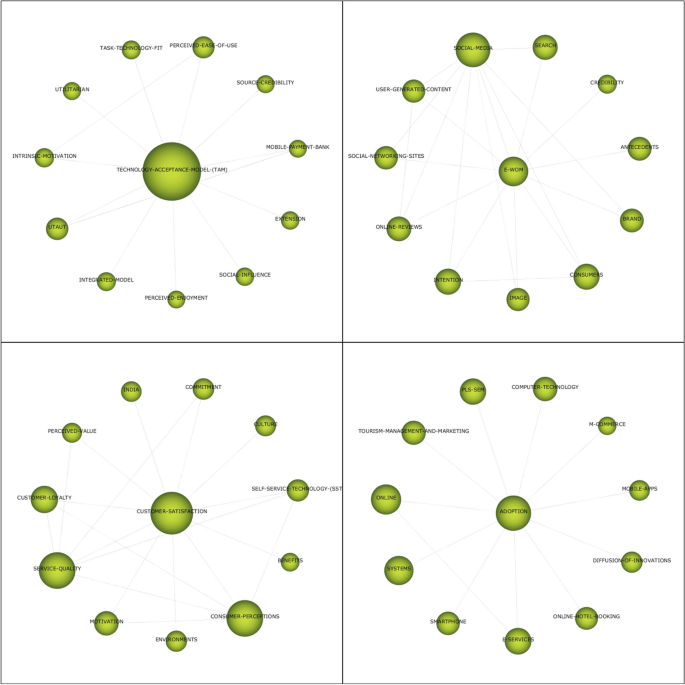
Cluster networks of the second quadrant (1988–2016)
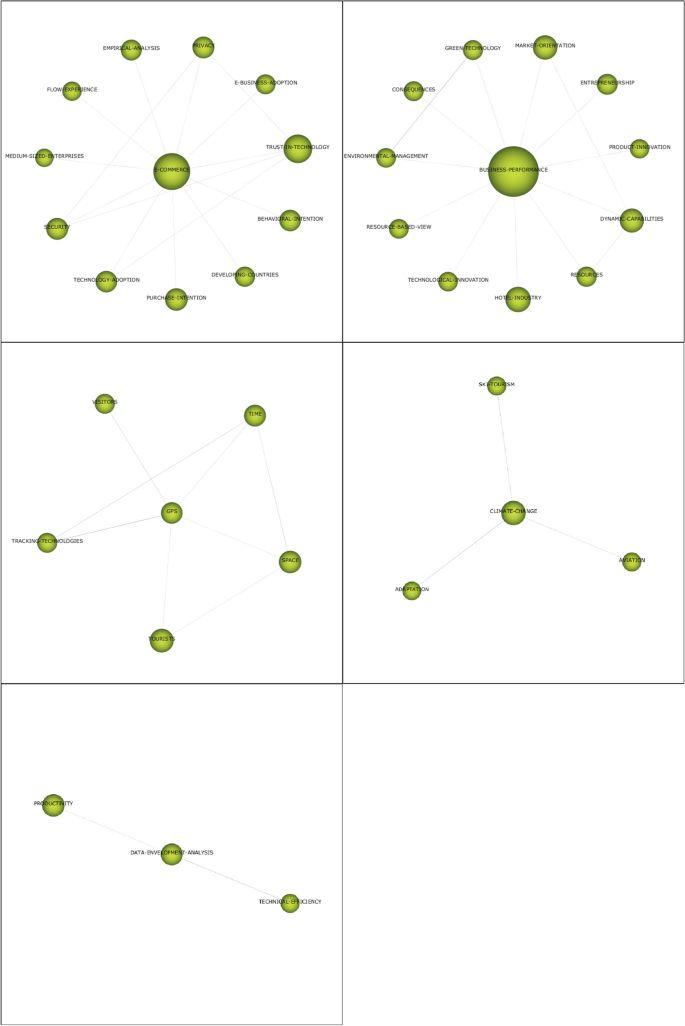
Cluster networks of the third quadrant (1988–2016)
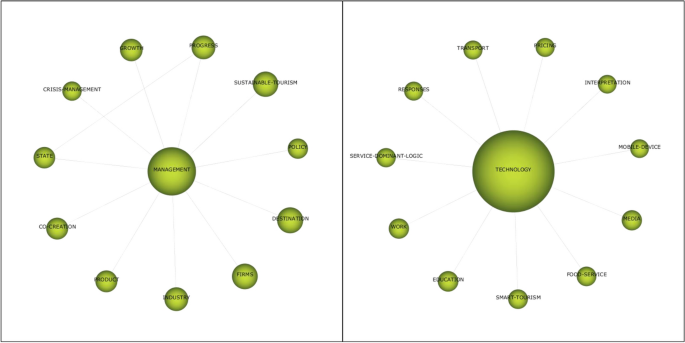
Cluster networks of the fourth quadrant (1988–2016)
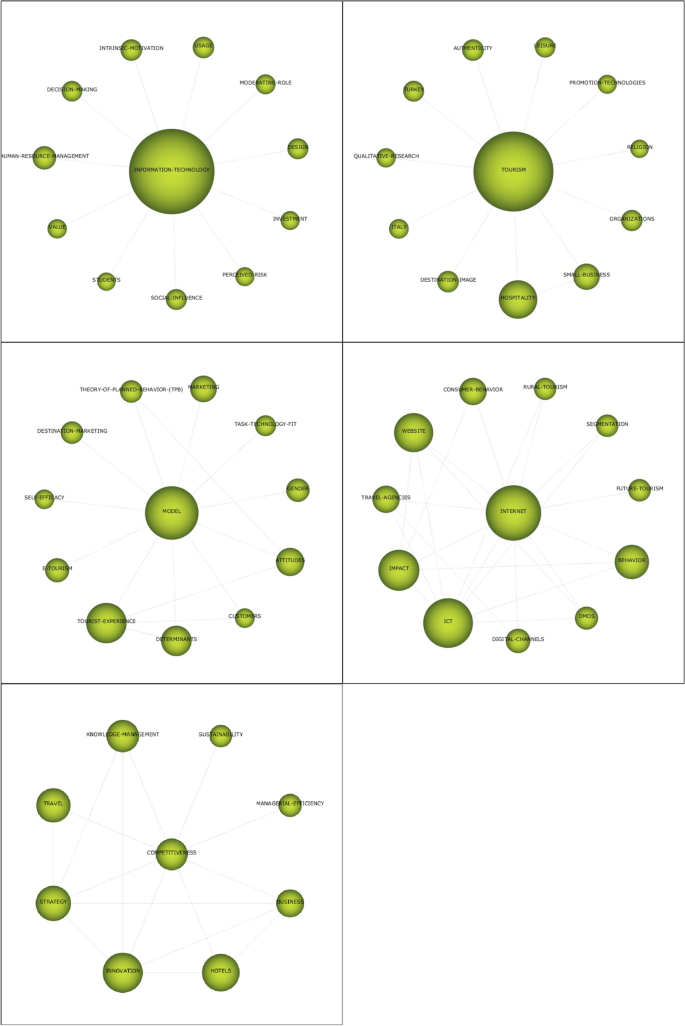
Cluster networks of the first quadrant (2017–2021)
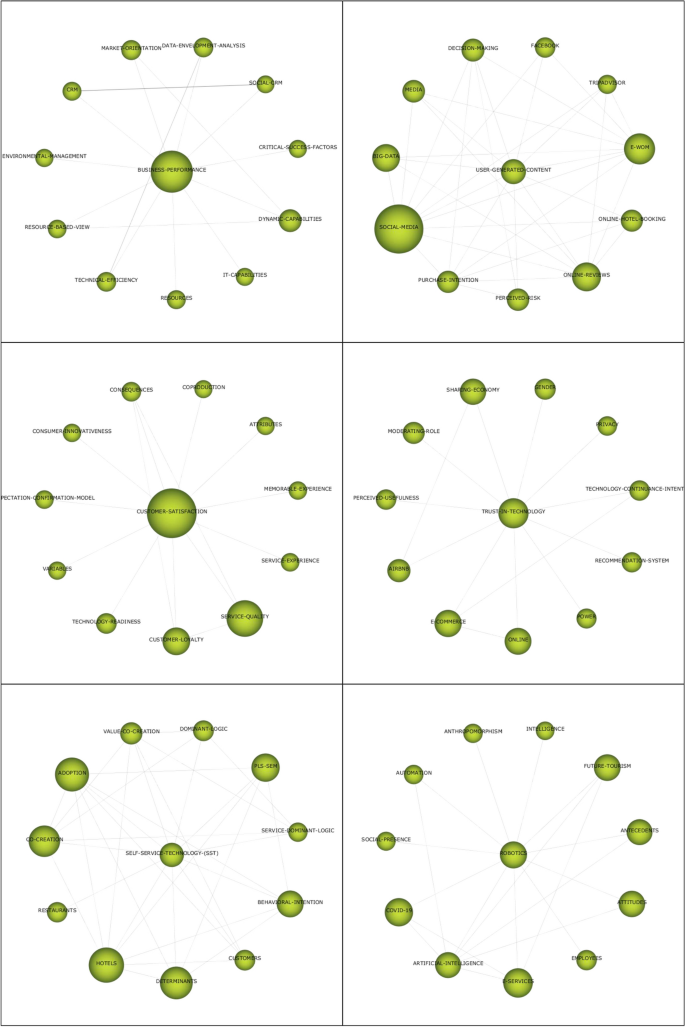
Cluster networks of the second quadrant (2017–2021)
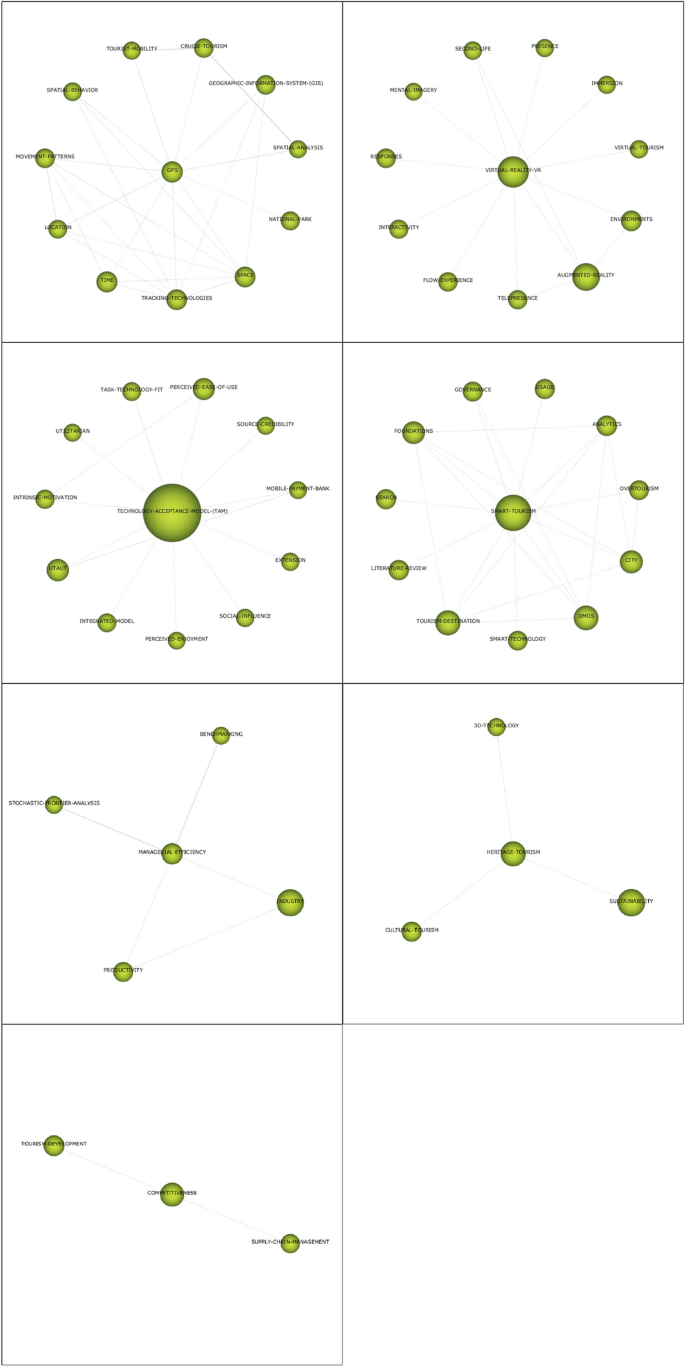
Cluster networks of the third quadrant (2017–2021)
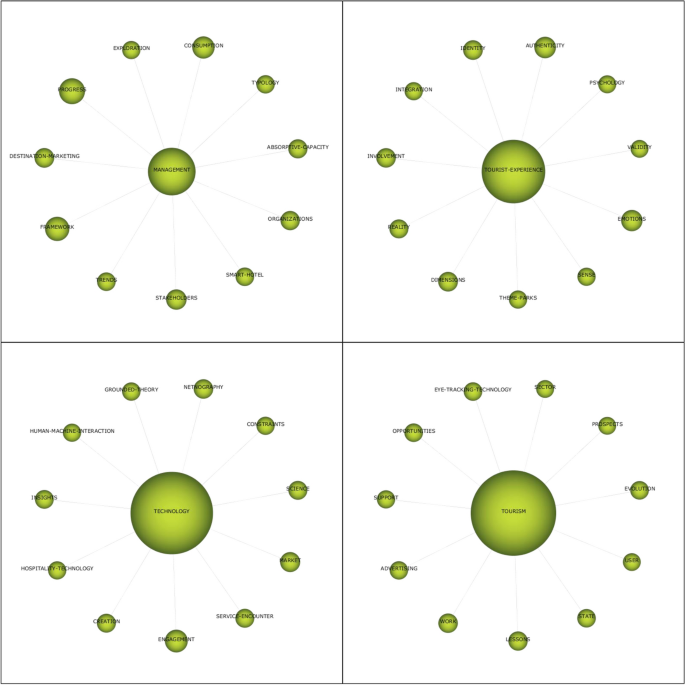
Cluster networks of the fourth quadrant (2017–2021)
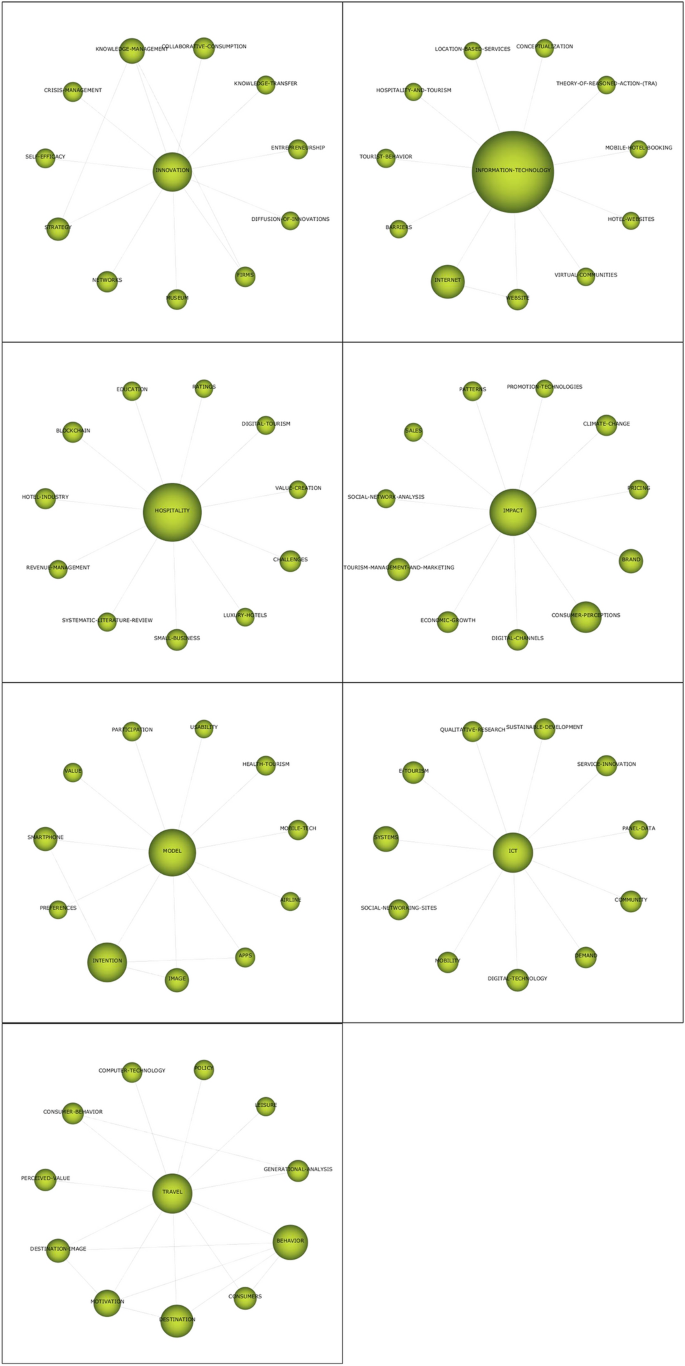
Rights and permissions
About this article
Cite this article
Molina-Collado, A., Gómez-Rico, M., Sigala, M. et al. Mapping tourism and hospitality research on information and communication technology: a bibliometric and scientific approach. Inf Technol Tourism 24, 299–340 (2022). https://doi.org/10.1007/s40558-022-00227-8
Received:
Revised:
Accepted:
Published:
Issue Date:
DOI: https://doi.org/10.1007/s40558-022-00227-8






